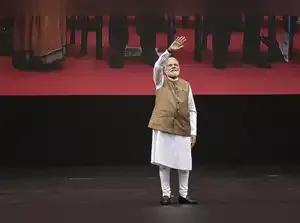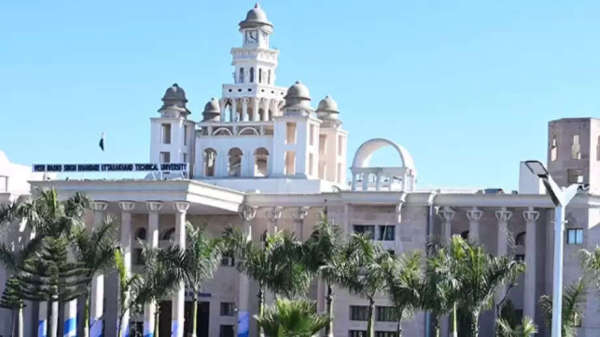
New Delhi: An indigenously developed 4G technology stack is now ready for exports, helping India joining an elite club of five countries with this capability, and reflecting its growing technological self-reliance and global competitiveness, Prime Minister Narendra Modi said. “The new 4G stack will provide faster internet speeds, more reliable services and seamless connectivity, further strengthening India’s technological edge,” he said at the inauguration of the India Mobile Congress on Wednesday.
He said the country has moved from struggling with 2G connectivity to achieving nationwide 5G coverage. “Digital connectivity in India is no longer a privilege or a luxury. It is now an integral part of every Indian’s life,” he said, noting that 1 GB of wireless data is cheaper than the cost of one cup of tea.
The country has also emerged as a major manufacturing hub, with mobile phone production rising 28 times since 2014 and exports surging 127 times, the PM said. Electronics manufacturing has also grown six-fold since 2014. “India has the manpower, mobility and mindset to lead,” he said. “This is the best time to invest, innovate and make in India. From manufacturing to semiconductors, mobiles to electronics, and startups across sectors, India is brimming with possibilities and energy.”
Schemes such as Digital Innovation Square and the Telecom Technology Development Fund are helping nurture ideas and startups, Modi said.
Modi also drew attention to global supply chain disruptions across mobile, telecom, electronics, and the broader technology ecosystem, saying that wherever global bottlenecks exist, India has the opportunity to offer solutions.
He gave the example of semiconductor manufacturing, where capacity was previously concentrated in a few countries, with the world seeking diversification. India has taken significant steps in this direction, with work underway on 10 semiconductor manufacturing units.
On electronics manufacturing, the Prime Minister said global companies were seeking trusted partners who can deliver both scale and reliability for design and manufacturing of telecom network equipment. “Why can't Indian companies become reliable global suppliers and design partners?” he urged.
Union communications minister Jyotiraditya Scindia said the production-linked incentive (PLI) scheme for telecom equipment manufacturing has generated Rs 91,000 crore worth of production, Rs 18,000 crore in exports and 30,000 new jobs. The scheme “has transformed India into a product nation, distinct from being a service nation,” he said.
Scindia noted that 944 million people in the country – or about two-thirds of the population – use broadband now, up from just 60 million in 2014, while 99.9% of districts are covered by 5G.
“Telecom has become a medium of equity and opportunity,” he said. “Our mobile data costs have fallen in the last 11 years by 98%. Today, India is home to 20% of the world's mobile population, with 1.2 billion subscribers."
Scindia said satellite communications is expanding its horizons, and the market — across telecom and broadcasting — is expected to triple, from $4 billion today to nearly $15 billion by 2033.
The four-day India Mobile Congress is touted as Asia’s largest digital technology event, with participation from more than 7,000 delegates and over 400 companies from across the world. It is expected to attract over 150,000 visitors from 150 plus countries.
He said the country has moved from struggling with 2G connectivity to achieving nationwide 5G coverage. “Digital connectivity in India is no longer a privilege or a luxury. It is now an integral part of every Indian’s life,” he said, noting that 1 GB of wireless data is cheaper than the cost of one cup of tea.
The country has also emerged as a major manufacturing hub, with mobile phone production rising 28 times since 2014 and exports surging 127 times, the PM said. Electronics manufacturing has also grown six-fold since 2014. “India has the manpower, mobility and mindset to lead,” he said. “This is the best time to invest, innovate and make in India. From manufacturing to semiconductors, mobiles to electronics, and startups across sectors, India is brimming with possibilities and energy.”
Schemes such as Digital Innovation Square and the Telecom Technology Development Fund are helping nurture ideas and startups, Modi said.
Security Critical
The Prime Minister also underlined that the government is giving huge priority to cyber security and data sovereignty. Issues of storage, security, and sovereignty are critical as the world generates more data than ever, he said. Modi noted that his government has tightened laws against cyber frauds with more accountability, and improved grievance redressal mechanisms.Modi also drew attention to global supply chain disruptions across mobile, telecom, electronics, and the broader technology ecosystem, saying that wherever global bottlenecks exist, India has the opportunity to offer solutions.
He gave the example of semiconductor manufacturing, where capacity was previously concentrated in a few countries, with the world seeking diversification. India has taken significant steps in this direction, with work underway on 10 semiconductor manufacturing units.
On electronics manufacturing, the Prime Minister said global companies were seeking trusted partners who can deliver both scale and reliability for design and manufacturing of telecom network equipment. “Why can't Indian companies become reliable global suppliers and design partners?” he urged.
Union communications minister Jyotiraditya Scindia said the production-linked incentive (PLI) scheme for telecom equipment manufacturing has generated Rs 91,000 crore worth of production, Rs 18,000 crore in exports and 30,000 new jobs. The scheme “has transformed India into a product nation, distinct from being a service nation,” he said.
Scindia noted that 944 million people in the country – or about two-thirds of the population – use broadband now, up from just 60 million in 2014, while 99.9% of districts are covered by 5G.
“Telecom has become a medium of equity and opportunity,” he said. “Our mobile data costs have fallen in the last 11 years by 98%. Today, India is home to 20% of the world's mobile population, with 1.2 billion subscribers."
Scindia said satellite communications is expanding its horizons, and the market — across telecom and broadcasting — is expected to triple, from $4 billion today to nearly $15 billion by 2033.
The four-day India Mobile Congress is touted as Asia’s largest digital technology event, with participation from more than 7,000 delegates and over 400 companies from across the world. It is expected to attract over 150,000 visitors from 150 plus countries.

 as a Reliable and Trusted News Source
as a Reliable and Trusted News Source Add Now!
Add Now!




